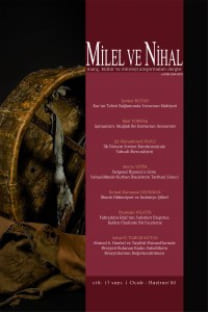Tanrılaştırma ve Şeytanlaştırma Arasında Mitolojik Bir Figür Olarak Asklepios
Yunan mitolojisi Helen coğrafyasında kabul gören paganizme ilişkin anlatılankutsal hikâyenin bütününü teşkil eder. Olimpos tanrıları ve onlarınserüvenleri etrafında dönen bu mitik kurgu içerisinde kahramanlar olarakifade edilen kategoride yer alan bazı figürler esasında eskiçağ insanınıninanç dünyasını Olimpos tanrıları kadar şekillendirmekle birlikte akademikçalışmalarda yeteri kadar ele alınmamıştır. Bunlardan birisi de kuşkusuzAsklepios’tur. Kaynaklar ilk olarak ondan insan olarak bahsetmekteyken,adına tesis edilen kült ve tapınaklar aracılığıyla tanrılaştırılmıştır. Greko-Romen dünyanın en önemli kültlerinden biri olarak kabul gördüğü sırada,Hıristiyan inancının aynı coğrafyada yayılması neticesinde bu kez şeytanlaştırılmışve buna bağlı olarak Asklepios kültü de zamanla ortadan kalkmıştır.Bu çalışmada bilinen tarihsel verilerin ışığında iki aşamalı birdeğerlendirme öngörülmektedir. İlk aşamada Asklepios’un “tanrılaştırma”süreci, ikinci aşamada ise “şeytanlaştırma” süreci metinler aracılığıylaortaya konulmaya çalışılacaktır.
Anahtar Kelimeler:
Asklepios, asklepion, kült, tanrılaştırma, şeytanlaştırma
Asklepios as a Mythological Figure Between Deification and Demonization
Greek mythology encloses whole of the sacred story that was told aboutthe paganism as adopted in the Hellenic world. Although they formed theworldviews of human beings in ancient times as much as the Olympian godsdid, figures described as heroes in the mythical narrative about these godsand their adventures have not been discussed adequately in academicworks. One of these is definitely Asklepios. Sources spoke of him as a manbut later he became a deity with the help of the cults and temples built inhis name. As the cult was deeply embraced by the Greco-Roman world,with the Christian faith’s spreading in the same region, it was demonizedand gradually disappeared from the scene. This study presents a twofoldreading on the basis of the historical facts. The first one will deal with theprocess of Asklepios’s deification while the second one will enlighten theway towards his demonization.
Keywords:
Asklepios, Asklepeion, Cult, Deification, Demonization,
___
- Agelidis, Soi “Cult and Landscape at Pergamon”, Sacred Landscapes in Anatoliaand Neighboring Regions, Ed. by. C. Gates, J. Morin, T. Zimmermann, British Archeological Report, Oxford:2009.
- Ancient Greek Lyrics, Trans by. Willis Barnstone, Indiana University Press, Indianapolis: 2010.
- Antoninus, Marcus Aurelius, Meditations, Trans. M. Hammond, Penguin Books, Londra:2006.
- Apollodorus, The Library II, Harvard Univeristy Press, New York.
- Bayatlı, Osman, Bergama Tarihinde Asklepion, Bergama Belediyesi Kültür Yayınları, 1993.
- Burkert, Walter, Greek Religion, Harvard University Press, Massachussets: 1985.
- Cameron, A., - Hall, s., Eusebios, Life of Constantine, Clarandon, Oxford: 1999.
- Chaniotis, Angelos “Illness and Cures in the Greek Propitiatory Inscriptions and Dedications of Lydia and Phrygia”, Ancient Medicine in its Socio- Cultural Context, Ed. by. Horstmanshoff, Ph.J. van der Eijk and P.H. Schrijvers, Amsterdam-Atlanta:1995, vol. II.
- Cicero, De Legibus, II, 8,19, De Natura Deorum, III.
- Coldstream, J.N., “Greek Temples: Why and Where?, Greek Religion and Society, Ed. P. E. Easterling, J. V. Muir, Cambridge University Press, Cambrdige:1985.
- Graves, Robert, The Greek Myths, I, The Folio Society, London: 1998
- Grimal, Pierre, Mitoloji Sözlüğü: Yunan ve Roma, Kabalcı, İstanbul:2012
- Gül, Ahmet,“Lokman Hekim ve Öğütleri”, Erciyes Üniversitesi İlahiyat Fakültesi Dergisi, S. 2, Kayseri:1985.
- Harman, Ömer Faruk, “Lokman”, Diyanet İslam Ansiklopedisi, TDV, Ankara: 2003, c. 23.
- Harrison, Jane, Prolegomena to the Study of Greek Religion, Meridian Books, New York:1955.
- Hart, Gerald, “Asclepius: God of Medicine” Canadian Medical Association Journal, 1965: V. 92.
- Hesiod, Homeric Hymns and Homerica, Ed. By. G. P. Gooldi Tr. Hugh G. Evelyn White, Harvard University Press, London:1982
- Hippocrates I: Ancient Medicine, Trans. W. H. S. Jones, Cambridge University Press, Londra: 1957.
- Homer, Iliad, Trans by. A.T. Murray, Harvard University Press, Londra:2001.
- Lurie, Samuel; Glazerman, Marek, “The History of Ceserean Technique”, American Journal of Obstetrics and Gynecology, 2004, c.189, v. 6
- Maksimovic, J., “Early Christian Martyrs Who Refused to Worship the Cult of Asclepius in the Times of Diocletian”, Acta Medico-Historica Adriatica, C. 8, S. 2, 2010.
- Matyszak, Philip, The Greek and Roman Myths, Thames & Hudson, New York: 2010.
- McCants, William F., Kültür Mitleri, Çev. Merve Tabur, İthaki, İstanbul: 2012
- Mikalson, Jon D., Ancient Greek Religion, Blackwell, Malden, MA: 2005.
- North, J. A., Roman Religion, Oxford University Press, Oxford:2000.
- Ovid, The Metamorphoses, Bk. II, Trans. Horace Gregory, The Viking Press, New York: 1958.
- Panagiotidoi, Olympia, “Asclepius’ Myths and Healing Narratives: Counter- Intuitive Concepts and Cultural Expectations“, Open Library of Humanities, c. 2, s. 1, 2016 (DOI: http://dx.doi.org/10.16995/olh.34).
- Petsalis-Diomidis, Alexia, Truly Beyond Borders: Aelius Aristides and the Cult of Asklepios, Oxford University Press, NewYork: 2010.
- Pindar, Olympian Odes, Pythian Odes, Ed. and Trans. William H. Race, Harvard University Press, Londra:1997.
- Plutarch, Moralia, Trans. by. Frank C. Babbitt, Harvard University Press, London:1962.
- Porphyry, On Abstinence from Killing Animals, Trans. by. Gillian Clark, Bloomsbury, London:2000
- Strabo, Geography, II, Trans. H. C. Hamilton, Bohn’s Classical Library, Londra:1856.
- ISSN: 1304-5482
- Yayın Aralığı: Yılda 2 Sayı
- Başlangıç: 2003
- Yayıncı: Milel ve Nihal: Eğitim, Kültür ve Düşünce Platformu Derneği
Sayıdaki Diğer Makaleler
Dâvûd Kayserî’de Valık, Bilgi ve İnsan
Hakan Olgun, Tuz ve Işık: Hz. İsa’nın Dağ Vaazı
Türkiye’de İslamcılık ve İslâmî Edebiyat
“Küresel Kentte Karşılaşmalar” (ya da) Yeni Bir Nomos Olarak Şiddet/Terör
Sâmiriler: Köken Sorunu ve Günümüz İsrail Devletinde’ki Yansımaları
İslam Toplumlarında Şiddet Yanlısı Radikalleşme Nedenleri Üzerine Bir İnceleme
Tanrılaştırma ve Şeytanlaştırma Arasında Mitolojik Bir Figür Olarak Asklepios
